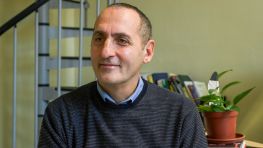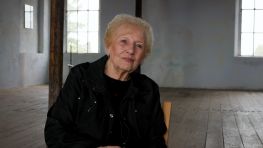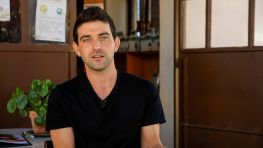
Giovanni "Giuanin" Pansarasa
Traditional agriculture in the Biellese Baraggia.
Giovanni Pansarasa, known as Giuanin, is an over-eighty-year-old farmer who, continuing the work of his parents, has contributed to transforming the harsh and stingy lands of the Biella Baraggia into small paddy rooms. Since he was a child he has known the roughness of peasant life, at the age of twelve he began plowing the land on behalf of third parties with the help of horses, continuing to help the family with milking and other hard work. Witness of a traditional agriculture that integrates cattle breeding with rice cultivation, he provided the Stocchi di Rovasenda family, precursors of organic rice cultivation, with some fundamental notions to formulate the "green mulch" method. Giovanni is a real historical memory of his territory, a profound connoisseur of natural resources and the traditions connected to them, he tells his world with passion. A narration that to those who play not only as a testimony of the past but, for the most sensitive ears, is proposed as a warning for future generations.
Video table of contents
- Always a farmer.
- My first job: plowing fields with horses.
- I didn't have time to study so I started working the rice fields with horses.
- The cows on the farm.
- The first customers who bought milk to make Gorgonzola.
- Clean and salt the cheeses.
- The increase in the cultivated area and the varieties of rice.
- Rice cutting: labor and cabbage in exchange for rice.
- Living in the winter: cabbage and pork, looking after the animals.
- Working the land in Baraggia.
- Brushes with plant roots.
- The coal-fired rice dryers.
- The small plains in Baraggia and the difficulty of growing rice in Baraggia.
- Thanks to the manure of the cows we were able to grow rice in Baraggia. Ground otherwise good only for making bricks.
- The "magicians of Baraggia": the oxen!
- The right plow for plowing in Baraggia.
- When the bulldozers arrived: bigger flats, like on the plain.
- By widening the plains they felled all the trees.
- La monda and the staff: they ate minestrone and meat only on Sundays. "Potatoes carrots and move on".
- The farmhouse without the farm workers has become a desert!
- The Second World War in the rice fields.
- The bunches: two women in front before the harvest.
- The blessing of tractors and horses for S. Antonio.
- Panissa for S. Antonio and at home.
- Risotto, the importance of a good broth.
- Wine was bad if you didn't eat a nice plate of rice as well.
- I always eat rice, now with toma cheese and gorgonzola.
- My daughter always wants pasta. I want risotto!
- The toma of Val Sesia.
- The rotation of land to grow rice.
- Twenty quintals per day.
- The use of manure in paddy fields.
- The importance of knowing your land.
- At school with Mr. Marchetti, Rosa Marchetti's father.
- Sow the lawn! The advice to the Stocchi not to use synthetic chemistry.
- Cow care: births and mastitis.
- We made the capons.
- The rice flower, the crossings, the cold during flowering.
- Frost and hail: one destroys everything the other leaves you with something.
- The agriculture of the past did not allow monoculture: it was necessary to diversify to survive.
- The magpie "gavassera", the pigeon favass, the crow.
- The otters arrived when I was already old.
- Raising pigeons. My father was a teacher.
- The strange couple: plowing with a horse and a cow!
Interview information
Country: IT
Region: Piemonte
City: Rovasenda
Giovanni Pansarasa
Year: 1933
City: Rovasenda
School: Junior High or Middle School
Profession: Farmer
Languages: Italiano
Document by: Luca Ghiardo
Video by: Luca Ghiardo
Created: 07-05-2021
Questo video fa parte del seguente archivio
Rice stories
Rice stories
Food is a fundamental resource for man and his health, both through the supply of nutrients and the ability to embody traits of human culture that play a leading role in our well-being.
Over time, each territory has built original ways in which to relate to the fruits of its land, enriching them with rituals, symbolic meanings and culinary customs. Much of these relationships have been lost following the years of the economic boom, with the exodus from the countryside to urban centers, with the advent of agriculture for mass production and ultimately with the globalization of markets and the consequent impoverishment of the heritage of biodiversity and ethnodiversity.
The purpose of this archive is to collect evidence relating to the main rice production area in Europe, that is the Po Valley, and to investigate, through the analysis of textual sources and testimonies collected in the field, both what survives of this heritage, and the ways in which which has evolved and reached us, paying particular attention to the explicit and implicit links that bind food and health.






